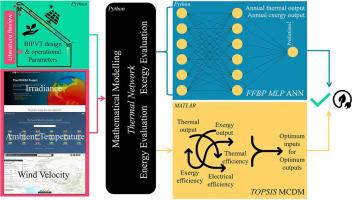Energy Conversion and Management ( IF 9.9 ) Pub Date : 2021-07-15 , DOI: 10.1016/j.enconman.2021.114488 Mohit Barthwal 1 , Dibakar Rakshit 1

|
Indian Himalayan Region (IHR) encompass approximately 16.2% of India’s geographical area and characterized as a montane climatic zone. The ambient temperature of this region is extremely low, with a minimum average temperature of 2–18 °C. Major settlements in this region are located at an altitude of more than 1000 m above sea level. Therefore, according to The Energy and Resources Institute (TERI), India, there is excessive thermal and electrical energy consumption in these regions pertaining to space heating. Moreover, the current energy sources utilized are not clean sources and hence contribute towards emissions. A building-integrated photovoltaic thermal (BIPVT) system is modelled to provide the necessary thermal energy alongside electricity for space heating intended for the climatic conditions of Srinagar. The study utilized an application-centric approach in modelling and analyzing the BIPVT system and, hence quantifying the annual outputs for Srinagar, India. Furthermore, the developed mathematical model is used for training an artificial neural network to predict the annual thermal and exergy outputs of the system based on six different model parameters. Three designs, one operational and two application-based parameters are considered as inputs to the network. Moreover, a multi-criteria decision-making method is employed to determine the best set of BIPVT parameters giving optimum annual thermal and exergy outputs along with electrical, thermal and exergy efficiencies of the modelled system. The modelled neural network performed reasonably well against the unseen test dataset in predicting the BIPVT yield with an value 0.97. An optimum annual thermal and exergy gains of 2,25,459 kWh and 67,132.38 kWh, respectively, are quantified for the best set of BIPVT parameters. The system’s optimum average electrical (power conversion), thermal and exergy efficiencies are observed to be 14.87, 56.28, and 17.59%, respectively.
中文翻译:

印度山地气候人工神经网络耦合建筑一体化光伏热力系统
印度喜马拉雅地区 (IHR) 约占印度地理区域的 16.2%,属于山地气候区。该地区的环境温度极低,最低平均温度为 2-18°C。该地区的主要聚居地位于海拔 1000 m 以上。因此,根据印度能源和资源研究所 (TERI) 的说法,这些地区与空间供暖相关的热能和电能消耗过多。此外,目前使用的能源不是清洁能源,因此有助于排放。对建筑集成光伏热能 (BIPVT) 系统进行建模,以提供必要的热能和电力,用于针对斯利那加气候条件的空间供暖。该研究利用以应用为中心的方法对 BIPVT 系统进行建模和分析,从而量化了印度斯利那加的年度产出。此外,开发的数学模型用于训练人工神经网络,以基于六个不同的模型参数预测系统的年度热输出和火用输出。三种设计,一种操作参数和两种基于应用的参数被视为网络的输入。此外,采用多标准决策方法来确定最佳的 BIPVT 参数集,从而提供最佳的年度热能和火用输出以及电、模型系统的热效率和火用效率。模型化的神经网络在预测 BIPVT 良率时,相对于未见的测试数据集表现得相当好。 价值 0.97。最佳年度热能和火用增益分别为 2,25,459 kWh 和 67,132.38 kWh,被量化为最佳 BIPVT 参数集。观察到系统的最佳平均电(功率转换)、热效率和火用效率分别为 14.87、56.28 和 17.59%。











































 京公网安备 11010802027423号
京公网安备 11010802027423号